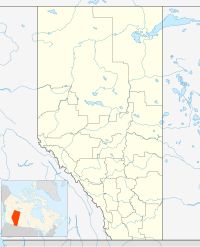
Beauvallon is a hamlet in central Alberta, Canada within the County of Two Hills No. 21. It is located on Highway 45, approximately 139 kilometres (86 mi) east of Edmonton.

Bellis is a hamlet in central Alberta, Canada within Smoky Lake County. Previously an incorporated municipality, Bellis dissolved from village status on January 1, 1946 to become part of the Municipal District of Vilna No. 575.

Boyne Lake is an unincorporated community in northern Alberta in the County of St. Paul No. 19, located 11 kilometres (6.8 mi) north of Highway 36, 142 kilometres (88 mi) northeast of Edmonton.

Duvernay is a hamlet in central Alberta, Canada within the County of Two Hills No. 21. It is located 1.6 km (1.0 mi) north of the intersection of Highway 36 and Highway 29 along the south bank of the North Saskatchewan River, approximately 53 km (33 mi) southwest of St. Paul. The hamlet of Brosseau is located immediately across the river along the north bank.

Flat Lake is an unincorporated community in central Alberta in the Municipal District of Bonnyville No. 87, located 6 kilometres (3.7 mi) south of Highway 28, 74 kilometres (46 mi) southwest of Cold Lake.

Fork Lake is an unincorporated community in northern Alberta, Canada. It is located in Lac La Biche County, 6 kilometres (3.7 mi) south of Highway 55 and 93 kilometres (58 mi) west of Cold Lake.

Green Court is a hamlet in central Alberta, Canada within Lac Ste. Anne County. It is located at the intersection of Highway 43 and Highway 18, approximately 127 kilometres (79 mi) northwest of Edmonton.

Hamlin is an unincorporated community in central Alberta in Smoky Lake County, located 15 kilometres (9.3 mi) south of Highway 28, 125 kilometres (78 mi) southwest of Cold Lake.

Iddesleigh is a hamlet in southern Alberta, Canada within Special Area No. 2. It is located approximately 37 kilometres (23 mi) northeast of Highway 1 and 46 kilometres (29 mi) northeast of Brooks.

Jenner is a hamlet in southern Alberta, Canada within Special Area No. 2. It is located approximately 43 kilometres (27 mi) northeast of Highway 1 and 54 kilometres (34 mi) northeast of Brooks. Previously an incorporated community, Jenner dissolved from village status on June 25, 1943.

Lottie Lake is a hamlet in northern Alberta, Canada within the County of St. Paul No. 19. It is located 1 kilometre (0.62 mi) west of Highway 36, approximately 138 kilometres (86 mi) northeast of Edmonton.

Spedden is a hamlet in central Alberta, Canada within Smoky Lake County. It is located 0.3 kilometres (0.19 mi) north of Highway 36, approximately 106 kilometres (66 mi) southwest of Cold Lake. It was named after one of the original surveyors who died in the area in 1919. Previously it was Cache Lake.

St. Vincent is a hamlet in northern Alberta, Canada within the County of St. Paul No. 19. It is located 3 kilometres (1.9 mi) south of Highway 28, approximately 79 kilometres (49 mi) southwest of Cold Lake.

Sunnynook is a hamlet in southern Alberta, Canada within Special Area No. 2. It is located approximately 10 kilometres (6.2 mi) east of Highway 36 and 86 kilometres (53 mi) northeast of Brooks. The hamlet formerly housed the Berry Creek Community School Division office and area post office until amalgamation of the school division into Prairie Land Regional Division.

Therien is a hamlet in central Alberta, Canada within the Municipal District of Bonnyville No. 87, located approximately 7 kilometres (4.3 mi) north of Highway 28 and 74 kilometres (46 mi) southwest of Cold Lake.

Wardlow is a hamlet in southern Alberta, Canada within Special Area No. 2. It is located approximately 24 kilometres (15 mi) east of Highway 36 and 45 kilometres (28 mi) northeast of Brooks.

Bank Bay is an unincorporated area in central Alberta, Canada within the Municipal District of Bonnyville No. 87. It is located on the bank of the Cold Lake Provincial Park.

Beaver River is an unincorporated area in central Alberta, Canada within the Municipal District of Bonnyville No. 87. It is named after the Beaver River that flows from Alberta to Saskatchewan.

Big Meadow is an unincorporated area in central Alberta, Canada within the Municipal District of Bonnyville No. 87. It is located near the Alberta Highway 28.
Alabam is an unincorporated community in Madison County, Arkansas, United States. The community is located on Arkansas Highway 127, approximately six miles northeast of Huntsville. The community of Old Alabam is about one mile south at the intersection of Highway 127 and U.S. Route 412. Alabam is on a broad ridge between War Eagle Creek to the southwest and the Kings River to the northeast.





